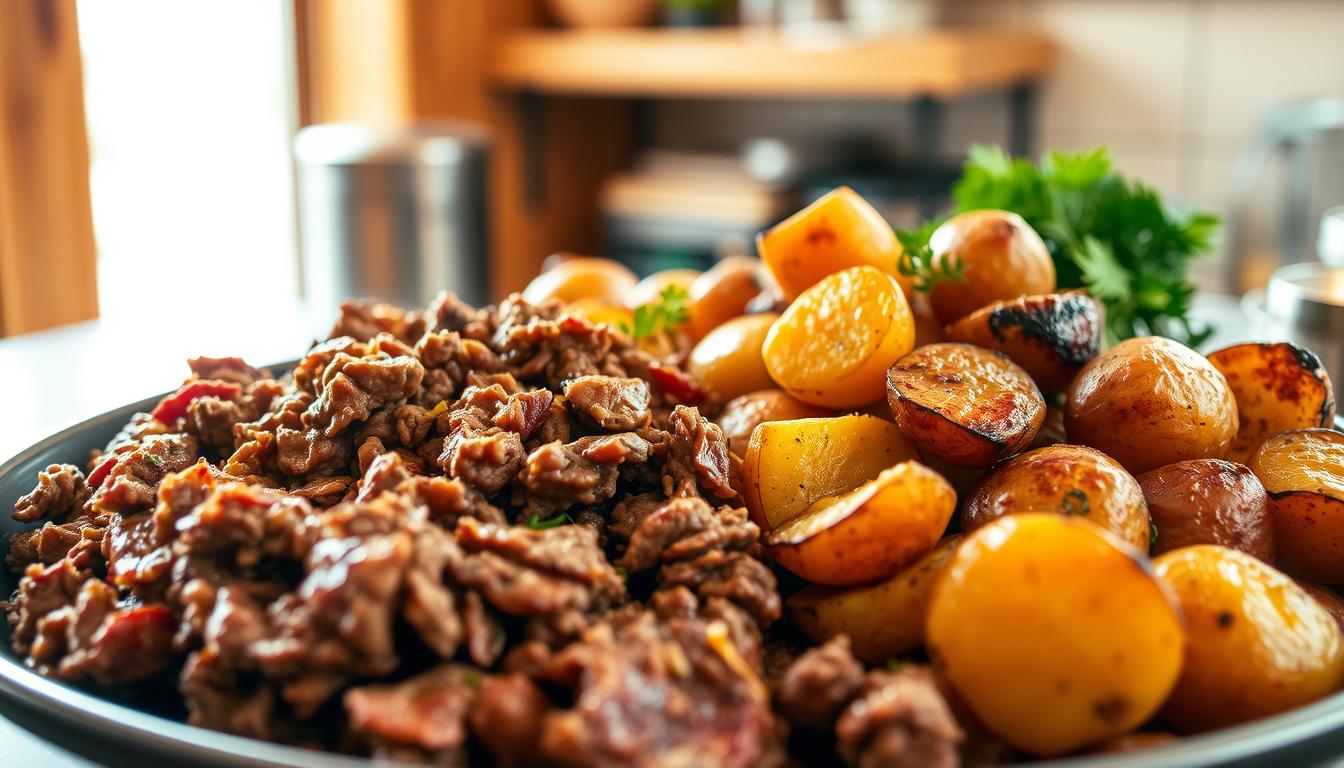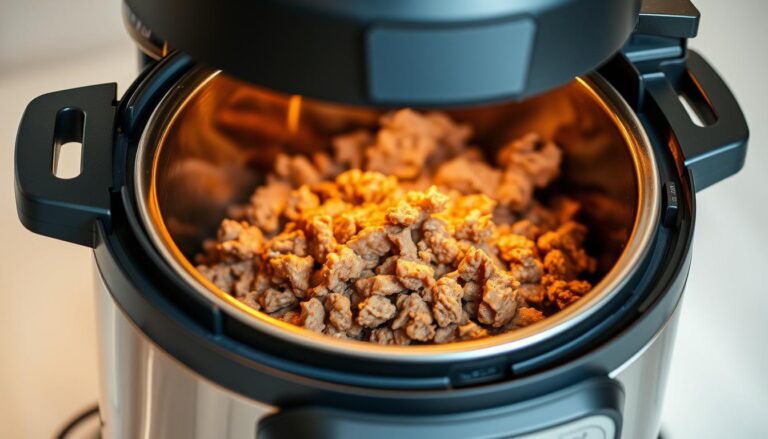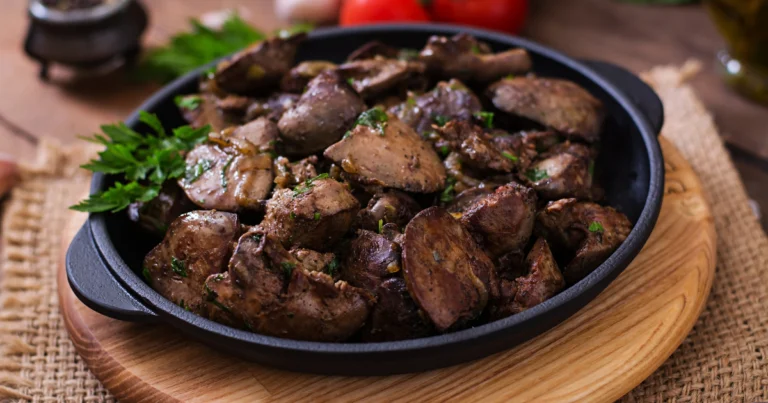Delicious Ground Beef and Potato Recipes
Craving a hearty meal that’s quick to prepare? Imagine juicy, seasoned meat paired with golden, tender spuds—all cooked in a single pan. The ground beef and potato recipes dish takes the classic comfort combo and elevates it into a modern staple for busy households.
You’ll love how this recipe balances simplicity with bold flavors. Lean protein and fiber-rich veggies come together in under an hour. Best of all, cleanup is a breeze thanks to the one-pan method. No more juggling multiple pots or scrubbing stubborn stains!
What makes this meal special? It’s endlessly customizable. Swap spices for a Tex-Mex twist or add cheese for extra richness. Kids adore the familiar flavors, while adults appreciate the balanced nutrition. Plus, leftovers taste even better the next day.
Table of Contents
Introduction: Embracing Hearty Ground Beef and Potato Dishes
There’s magic in meals that bring everyone to the table without fuss. Families across America treasure this ground beef and potato recipes creation for its cozy flavors and stress-free prep. One bite delivers nostalgia and nourishment in equal measure.
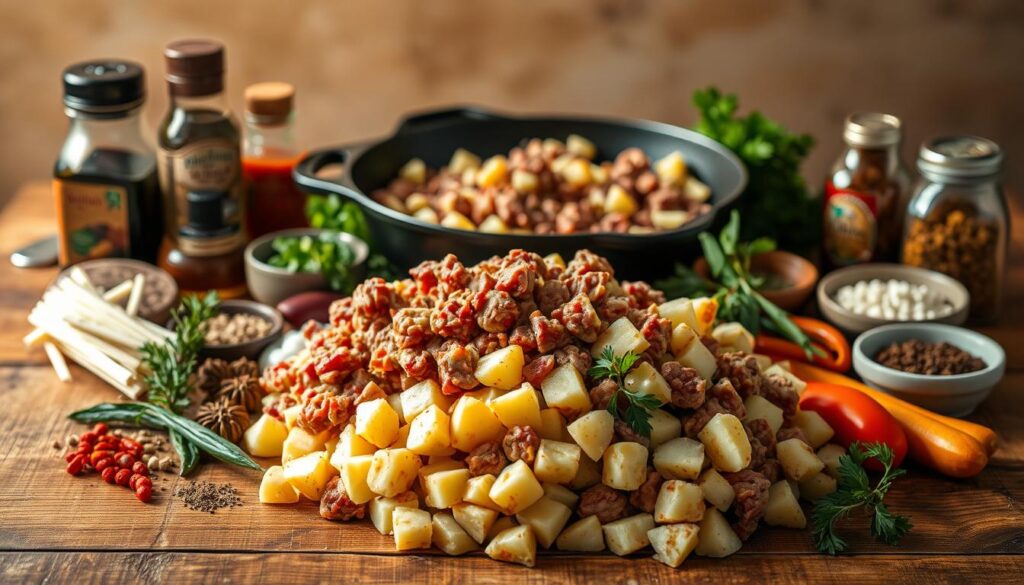
A Family Favorite Meal
Weeknight dinners transform into cherished moments with this dish. Crispy-edged spuds mingle with seasoned protein, while colorful peppers add sweetness. Kids often request seconds, unaware they’re eating three vegetable varieties.
| Feature | Family Benefit | Prep Advantage |
|---|---|---|
| 30-minute cook time | Quick service for hungry kids | Minimal active cooking |
| Single skillet use | Fewer dishes to wash | Even heat distribution |
| Customizable spices | Adjust for picky eaters | Pantry-friendly staples |
What Makes This Recipe Special
Quality starts with lean protein and waxy Yukon golds that hold their shape. Cast iron skillets develop deeper flavors through perfect searing. Fresh garlic and paprika create layers that jarred seasonings can’t match.
This isn’t just sustenance—it’s edible comfort. Leftovers become next-day lunches, tasting richer after flavors meld. Nutritious elements hide in plain sight, making it a parent-approved crowd-pleaser.
ground beef and potato recipes
Some food pairings stand the test of time for good reason. When seared protein meets soft, caramelized starch, you get a texture symphony that satisfies every bite. This dynamic duo creates balanced meals where richness and subtle sweetness play off each other perfectly.
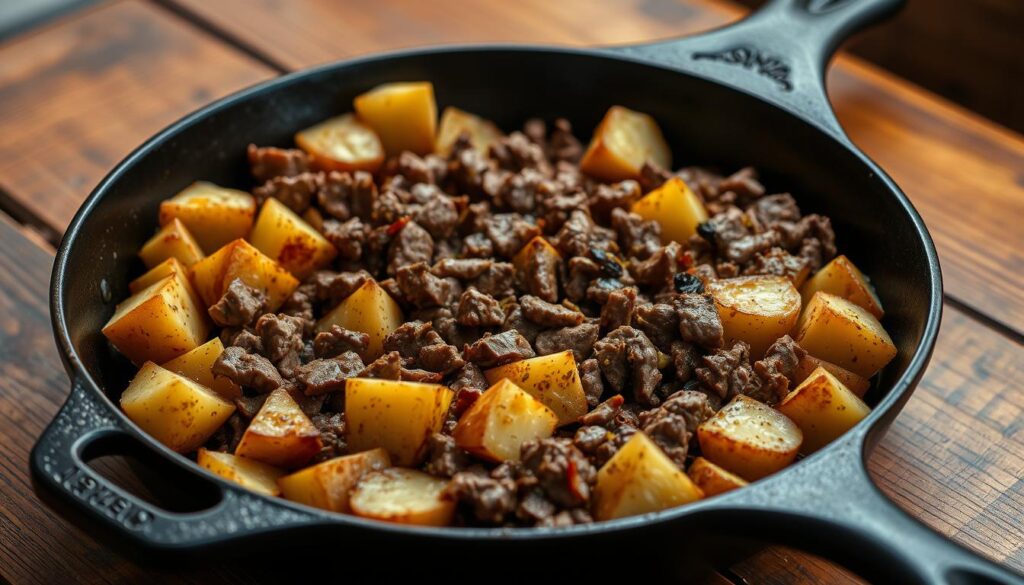
The Science of Satisfaction
Cooking meat and tubers together unlocks flavor chemistry. Browning creates the Maillard reaction, producing complex aromas that pre-made sauces can’t replicate. Spices like smoked paprika cling to both ingredients, building layered taste profiles.
Single-pan preparation does more than save dishwashing time. Shared cooking juices infuse potatoes with savory depth while keeping meat moist. “You’re essentially creating a flavor loop,” says chef Marcus Wareing. “Every ingredient enhances its neighbors.”
| Component | Flavor Role | Practical Benefit |
|---|---|---|
| Protein Base | Provides umami richness | Quick-cooking protein source |
| Starchy Foundation | Balances textures | Absorbs excess fats |
| Shared Skillet | Unifies seasonings | Simplifies meal prep |
Family-centric meals thrive on this ground beef and potato recipes. Kids recognize the familiar elements, while adults appreciate clever upgrades like roasted garlic or fresh herbs. Swap cumin for rosemary, or add diced zucchini – the structure stays reliable even when flavors shift.
Weeknight warriors love its chameleon-like adaptability. Transform leftovers into breakfast hash or taco fillings without extra effort. This dish isn’t just dinner – it’s tomorrow’s lunch solved.
Selecting Quality Ingredients and Tools
Great meals start with smart choices long before heating the skillet. Picking premium components and having the right equipment transforms simple dishes into memorable ones.
Choosing the Right Protein and Spuds
Opt for lean ground (85/15 ratio) to reduce grease without sacrificing moisture. Yukon golds work best for creamy textures, while russets offer crisp edges when roasted. Both absorb flavors beautifully during cooking.
Sweet onions like Vidalia balance savory notes, and red bell peppers add vibrant color. Remove seeds for milder flavor or keep them for extra crunch. Pre-chopped veggies save time during prep without compromising freshness.
Essential Kitchen Tools for One-Pan Cooking
A 12-inch cast iron skillet ensures even heat distribution for perfect browning. Keep these within reach:
- Sharp chef’s knife for uniform dicing
- Hamburger chopper to crumble meat efficiently
- Nested prep bowls for organized ingredient staging
Quality tools streamline cooking processes. The right skillet prevents sticking, while a sturdy spatula handles flipping without breaking apart tender components. Set up your workspace with measuring spoons and oil within arm’s reach before turning on the burner.
You can print recipe from here.
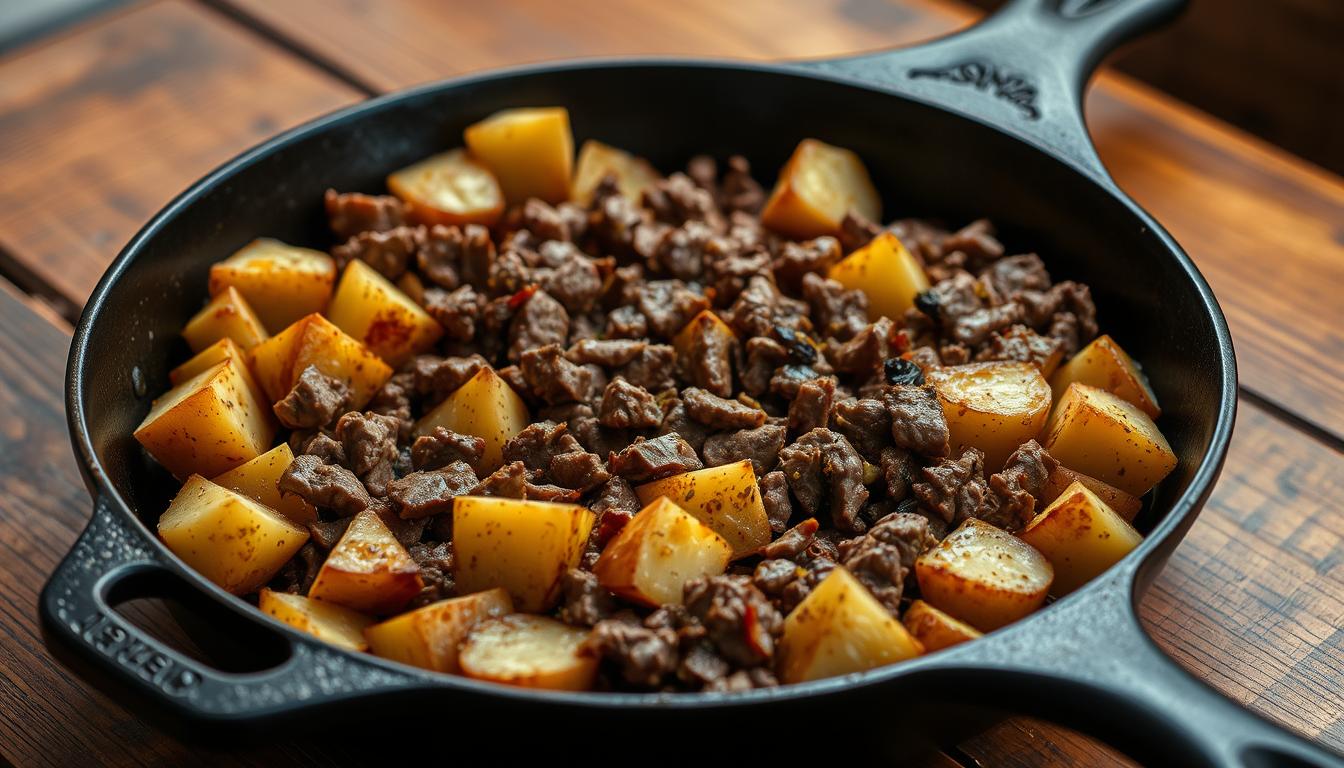
Delicious Ground Beef and Potato Recipes
Ingredients
Equipment
Method
- Prep the Potatoes : Wash and thinly slice the Yukon Gold potatoes. Dice the onion and bell pepper. Mince the garlic.
- Cook the Potatoes : In a large 12-inch skillet, heat 2 tbsp oil over medium heat. Add the potatoes in a single layer. Cook 6–8 minutes per side, flipping when golden and crispy. Remove from pan and set aside.
- Brown the Beef : In the same skillet, add the ground beef. Break it up with a spoon or hamburger chopper. Cook 5–7 minutes until browned. Drain excess fat, leaving 1 tbsp in the pan.
- Sauté Vegetables & Spices : Add diced onions and bell pepper. Cook 3–4 minutes. Stir in garlic, smoked paprika, garlic powder, salt, and pepper. Cook 30 seconds until fragrant.
- Combine & Simmer : Return the potatoes to the skillet. Add ¼ cup broth to deglaze the pan. Stir gently to combine. Let simmer 2–3 minutes until everything is heated through and coated.
- Optional Add-Ins : Top with cheese, parsley, or lime crema. Serve hot as-is or with tortillas, rice, or salad on the side.
Notes
- Potato Options: Yukon Golds are ideal for creamy texture and hold their shape well. For crispier edges, try Russet potatoes. You can also use red potatoes or sweet potatoes for variety.
- Make It Spicy: Add 1 tsp chili powder or a diced jalapeño for a kick. Smoked paprika adds depth, but chipotle powder works well too for a smokier profile.
- Cheesy Upgrade: Stir in shredded cheddar or Monterey Jack at the end of cooking. Let it melt before serving for a gooey, comforting finish.
- Vegetable Variations: Mix in zucchini, corn, spinach, or mushrooms to boost the veggie content. Stir leafy greens in at the end to preserve texture and nutrients.
- Leftover Ideas: Use leftovers as a breakfast hash—just top with a fried egg. You can also stuff them into tortillas for tacos or mix with eggs for a quick frittata.
- Skillet Tips: Avoid overcrowding the potatoes to ensure they crisp up. A well-seasoned cast iron skillet delivers the best results, but a nonstick pan works in a pinch.
- Storage Tip: To prevent soggy reheated potatoes, line the storage container with parchment paper or reheat in a hot skillet instead of the microwave.
Step-by-Step Cooking Techniques for a One-Pan Meal
Mastering Mastering skillet meals requires precision and patience on skillet meals requires precision and patience. Let’s break down the process into three key phases, ensuring each element shines while harmonizing with others. Proper heat management and timing turn basic ingredients into something extraordinary.
Sautéing Potatoes to Golden Perfection
Start by heating 2 tablespoons of oil in your skillet over medium heat. Add evenly sliced spuds in a single layer—overcrowding causes steaming instead of crisping. Cook for 6-8 minutes per side, flipping once edges turn amber. “The sizzle should sound like applause, not a wildfire,” advises chef Lidia Bastianich.
Browning Lean Ground Beef and Perfecting the Skillet
Crumble your protein into the hot pan, breaking it apart with a wooden spoon. Maintain medium-high heat to develop a rich crust without drying out the meat. Drain excess fat after 5-7 minutes, reserving 1 tablespoon for flavor. This step locks in juices while creating fond—those tasty browned bits at the skillet’s base.
Combining Flavors with Spices and Sauces
Reduce heat to medium and add minced garlic, stirring for 30 seconds until fragrant. Sprinkle 1 tablespoon each of smoked paprika and garlic powder, coating every morsel. Deglaze with ¼ cup broth, scraping the pan to incorporate caramelized flavors. Simmer for 2-3 minutes as liquids thicken into a glossy glaze.
| Stage | Key Action | Time Guide |
|---|---|---|
| Potato Prep | Even slicing & flipping | 12-16 minutes |
| Protein Browning | Crumbling & draining | 5-7 minutes |
| Flavor Fusion | Spice blooming | 3-5 minutes |
Variations and Substitutions to Suit Your Taste
Transform your skillet creation into a global feast or dietary-friendly masterpiece with smart swaps. This dish’s flexible framework invites bold experiments while keeping prep times under 30 minutes.
Mexican-Inspired Twists and Cheese Options
Kick up the heat with 2 teaspoons chili powder and smoked paprika for depth. Fold in diced jalapeños or poblano peppers during the cooking process. Finish with a blanket of shredded cheddar or crumbled queso fresco for melty indulgence.
Boost richness by stirring ¼ cup enchilada sauce into the meat mixture. Top servings with lime crema—mix 3 tablespoons sour cream with 1 teaspoon lime zest. “The tang cuts through the spice beautifully,” notes food blogger Gina Homolka.
Alternative Proteins and Vegetable Additions
Swap proteins for lean turkey or chicken while keeping cooking times identical. Vegetarian? Try plant-based crumbles or rinsed lentils. Both absorb spices like chameleons.
Refresh the veggie lineup with zucchini ribbons or roasted corn kernels. Bell peppers add crunch, while spinach wilted at the end boosts nutrients. Adjust seasoning with an extra ½ teaspoon garlic powder if needed.
| Swap | Flavor Impact | Prep Tip |
|---|---|---|
| Turkey | Milder taste | Add 1 tsp oil |
| Mushrooms | Earthy notes | Sauté first |
| Black beans | Tex-Mex vibe | Rinse well |
Tips for Perfect Skillet Cooking
Perfect ground beef and potato recipes demand more than just good ingredients—they require smart technique. Whether you’re searing proteins or caramelizing veggies, these strategies ensure restaurant-quality results every time.
Avoiding Sticking and Overcooking
Start with a hot pan and 1-2 tablespoons of oil—the sizzle test never lies. Chef Jamie Oliver notes, “If your fat isn’t shimmering, your food will cling like a stage-five clinger.” Cast iron works best for even heat distribution, while stainless steel offers quick temperature control.
Keep proteins moving during the first 30 seconds of cooking to prevent adhesion. For spices like garlic powder, add them after browning to avoid burning. Monitor heat levels closely—if smoke appears, reduce the flame immediately.
| Issue | Prevention | Tool |
|---|---|---|
| Sticking | Proper fat layer | Metal spatula |
| Overcooking | Timer use | Instant-read thermometer |
| Uneven heat | Preheated pan | Cast iron skillet |
Store leftovers in airtight containers within two hours. When reheating, sprinkle 1 teaspoon of water to revive textures. Pro tip: Line containers with parchment paper to prevent sauce absorption.
Creative Serving Ideas and Sides
Elevate your ground beef potatoes presentation with simple yet impactful touches that turn everyday dishes into culinary highlights. Strategic pairings and plating techniques can transform this hearty skillet creation into a restaurant-worthy experience.
Pairings That Enhance the Flavor
Brighten the taste profile for ground beef with fresh cilantro or parsley sprinkled just before serving. A squeeze of lime adds zesty contrast to rich flavors. For sides, consider these crowd-pleasers:
- Jasmine rice served in individual cups for portion control
- Avocado corn salad with cherry tomatoes
- Warmed tortillas for handheld servings
Chef Yotam Ottolenghi advises, “Contrasting textures make each bite exciting—think creamy dips alongside crunchy veggies.” Try pairing with tangy Greek yogurt or pickled red onions.
Serving Suggestions for a Complete Meal
Portion leftovers into meal-prep containers for easy lunches over three days. For dinners, layer the dish in a rustic pot alongside colorful sides. Create visual appeal by:
| Presentation Style | Best For | Key Element |
|---|---|---|
| Family-style skillet | Casual gatherings | Cast iron aesthetics |
| Individual bowls | Portion control | Layered ingredients |
| Charcuterie board | Appetizer spreads | Dipper variety |
Transform breakfast by topping fried eggs with leftovers, or stuff bell peppers for baked servings. The possibilities adapt to any occasion—from quick weeknights to weekend brunches.
How to Store and Reheat Leftovers Effectively
Proper storage of beef potatoes transforms leftovers into next-day delights. Follow these methods to maintain texture and taste while keeping meals safe. Your skillet creation deserves careful handling to shine beyond its first serving.
Storage Best Practices
Transfer cooled portions of ground beef potatoes to airtight containers within two hours of cooking. Layer ingredients to protect delicate textures—place spuds at the bottom to prevent sogginess. Refrigerate for up to three days for optimal flavor retention.
| Method | Duration | Texture Impact |
|---|---|---|
| Refrigeration | 3 days max | Minimal softening |
| Freezing | Not recommended | Mushy results |
Reheating Without Losing Texture
Warm your ground beef potatoes gently in a skillet over low heat. Add 1 teaspoon of broth or water to revive moisture. For a casserole-like finish, sprinkle shredded cheddar during the last minute. Cover briefly to melt cheese without overcooking proteins.
Microwave users: Use 50% power and stir every 30 seconds. Top with fresh herbs post-reheating to brighten flavors. “Low-and-slow is the golden rule,” says food safety expert Dr. Karen Adler. “Rushing ruins textures.”
Conclusion
Your kitchen deserves a hero dish that masters simplicity and satisfaction. This hearty favorite proves quality meals don’t require complex steps or hours of prep time. With smart seasoning and beef potatoes, you’ll create balanced flavors that keep everyone asking for seconds.
Remember: a pinch of salt and proper timing transform basic ingredients into something extraordinary. Whether swapping spices or adding veggies, the recipe adapts to your cravings while keeping cook times under 30 minutes. That’s the beauty of flexible, family-friendly meals—they grow with your tastes.
Treat each attempt as a chance to refine your skills. Start with fresh meat and precise heat control, then experiment confidently. Great dishes thrive on this balance of structure and creativity. Now grab your skillet—delicious results await both your patience and appetite.

